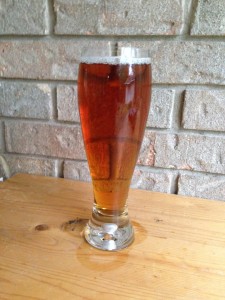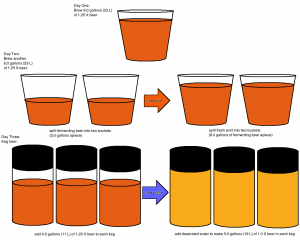 We post a fair amount of recipes on Beer and Wine Journal. Here are the ten that got the most traffic in 2014.
We post a fair amount of recipes on Beer and Wine Journal. Here are the ten that got the most traffic in 2014.
Top 10 Homebrewing Recipes of 2014
Fortified Winter Warmer (3-gallon/11-L partial mash version)
 Winter isn’t over yet, and winter warmers can — and should, if you ask me — be enjoyed throughout the winter, not just over the holidays. Here’s a 3.0-gallon (11-L) partial mash version of my spiced winter ale that could be ready by mid-February if you brew it around the New Year. [The 5.0-gallon (19-L) version was posted earlier.]
Winter isn’t over yet, and winter warmers can — and should, if you ask me — be enjoyed throughout the winter, not just over the holidays. Here’s a 3.0-gallon (11-L) partial mash version of my spiced winter ale that could be ready by mid-February if you brew it around the New Year. [The 5.0-gallon (19-L) version was posted earlier.]
If you make the specified-sized yeast starter, the 8% ABV base beer should ferment and condition in about 6 weeks. Adding the “spice” — the Scandinavian liquor aquavit — bumps the beer up to 9% ABV and adds a hint of the anise-like character of caraway. Because the spicing of aquavit is consistent, you can be assured of hitting a reasonable level of spicing every time. [And since I only like a hint of spice, you can add more aquavit if you’d like more “licorice” character (and alcohol).]
Rauchbier (And Winter Lagering Tips)
Winter is great time for many homebrewers to try brewing a lager. The fundamentals of brewing lager beer do not vary with the seasons. However, for homebrewers without an actively-cooled fermentation chamber, colder outside temperatures may provide a seasonal opportunity.
If you look around your house, you may find places — such as a basement or attic — that are significantly cooler than the rest of the house. Depending on where you live, an unheated garage or outdoor shed may also fall within a usable temperature range for a period of time. [Read more…]
Cranberry Zinger (All-grain)
Thanksgiving is two weeks away and so today I’m posting the all-grain version of my Cranberry Zinger — a great beer to serve on Thanksgiving day. Quick and easy to brew, and virtually foolproof, this is a great seasonal beer.
The all-grain version differs slightly from the extract version. Basically, the OG is little lower, but don’t worry — it’s not brain surgery. Almost any wheat beer base from 10–13 °Plato (1.040–1.052), all-grain or extract, will work fine. This recipe actually makes a nice American wheat beer, so you could brew 10 gallons (38 L) and split half into a straight up American wheat beer and add fruit to the second half.
Cranberries are tart, and they are also a bit tannic. The orange pith in the recipe (part of the whole orange) gives some added bitterness beyond the hopping (which is low). The dry, tart, slightly puckering flavor (and mouthfeel) of the beer is accentuated by the high level of carbonation.
This beer ferments quickly (3–4 days) and, after the beer has contacted the fruit for about a week, you can keg it and it will be ready to go. If you keg your beer, you can brew the base this weekend and have it ready for Thanksgiving.
Articles on Brewing Big Beers From Our First Year
 Beer and Wine Journal turned one year old about a month ago. During that time, I’ve posted a couple compilations of articles that ran in our first year, including brewing science stories and articles about all-grain brewing (and, of course, the requisite top 10 list). Here’s a list of our best articles on brewing strong beers.
Beer and Wine Journal turned one year old about a month ago. During that time, I’ve posted a couple compilations of articles that ran in our first year, including brewing science stories and articles about all-grain brewing (and, of course, the requisite top 10 list). Here’s a list of our best articles on brewing strong beers.
Vienna Lager Recipe
 Here is my recipe for Vienna lager. It employs a single decoction mash for wort production and uses kräusening to produce a crisp lager beer without that “homebrew lager” flavor. It takes a little extra effort to make, but results in an excellent “all-around” beer.
Here is my recipe for Vienna lager. It employs a single decoction mash for wort production and uses kräusening to produce a crisp lager beer without that “homebrew lager” flavor. It takes a little extra effort to make, but results in an excellent “all-around” beer.
Wiener Blut
Vienna Lager
by Chris Colby
All-grain; English units
DESCRIPTION
An all-around, well-balanced amber lager. Malty, from Vienna malt and a single decoction mash, but also hopped enough to provide balance. Moderate body and carbonation.
Cream Ale/American Pilsner Recipe
It’s summer. It can get hot as hell at times, especially after some yard work or exercising. Even the most dedicated homebrewer or craft beer aficionado can occasionally appreciate a “fizzy yellow lager” — or the ale equivalent — under these circumstances. They’re crisp, they’re light, they’re effervescent — and sometimes, they’re just the thing to slake your thirst. If you’d like to brew a cream ale or American Pilsner style beer, here’s a countertop partial mash recipe for 5.0 gallons (19 L) that will show you how. (And if you’re an unbearable craft beer purist who is absolutely compelled to turn up his nose at this style of beer, go check out my series on Russian imperial stouts.)
The biggest keys to success here are using the freshest possible ingredients, not scorching the extract, and running a good fermentation. If you use old liquid malt extract, the color of your beer will be too dark, and you’ll probably taste a little oxidation. You’ll add more unwanted color to the beer of you scorch the malt extract. (So, dissolve it in wort first.) Running a good fermentation will keep the beer crisp and free from excessive yeast-derived aromas (esp. esters, which you want to minimize in this type of beer). If you’re brewing the lager version, consider kräusening it.
And finally, if you want to brew this in the traditional manner, brew the beer initially as a fairly strong beer (around OG 1.064), then dilute it to working strength with deaerated water in the keg. (The recipe gives the straightforward method of brewing the beer — no kräusening or high-gravity brewing. But those techniques aren’t too hard to add, if you’d like.)
If you’ve never brewed a beer using a countertop partial mash before, review the technique before you start. You’ll need a 2-gallon beverage cooler with a spigot, and a large steeping bag in addition to your usual extract brewing equipment.
15 Gallons (57 L), Fast (Example Recipe)
 On Wednesday, I posted a method describing how to make 15 gallons (57 L) of beer (relatively) quickly, with a basic a 5.0-gallon (19-L) brewing setup. The idea was that you could make 15 gallons (57 L) of beer — something that would normally take three brew days at the 5.0-gallon (19-L) scale — in two brew days. If you were brewing for a party, but your brewing equipment was limited to the 5.0-gallon (19-L) ballpark, this could be just the thing.
On Wednesday, I posted a method describing how to make 15 gallons (57 L) of beer (relatively) quickly, with a basic a 5.0-gallon (19-L) brewing setup. The idea was that you could make 15 gallons (57 L) of beer — something that would normally take three brew days at the 5.0-gallon (19-L) scale — in two brew days. If you were brewing for a party, but your brewing equipment was limited to the 5.0-gallon (19-L) ballpark, this could be just the thing.
Exercise Recovery Ale (Recipe Formulation)

I need to brew a beer to drink after a good run. (Of course, this also means I have to start running again.)
When 2014 rolled around, I made big plans to brew a bunch. Then . . . a whole bunch of crap happened. The crappiest bit was injuring my elbows such that I lost sensation in, and the ability to move, some of my fingers. (Yes, those fingers. The ones I was going to use for brewing.!) Luckily, if you you wear an uncomfortable brace every night and are diligent about doing some exercises that make you look like an idiot every day, nerves can heal and suddenly you’re healthy again — and chomping at the bit to brew.
The other thing I have been doing is losing weight. For general health reasons, I decided I needed to drop some weight and I’ve lost about 25 lbs. (11 kg) since February. And now I’ve decided to get back into running — which brings me to today’s recipe. I’ve always thought it would be great to brew an “exercise recovery beer,” a beer to replenish some water and electrolytes after a workout. After some thought — and taste trials of mixing things into finished beer — I’ve hit on this recipe.
Russian Imperial Stout (All-Grain Recipe)
 This is a recipe for a Russian imperial stout, to go along with my series on Russian imperial stout. There is also an extract-based recipe for this beer.
This is a recipe for a Russian imperial stout, to go along with my series on Russian imperial stout. There is also an extract-based recipe for this beer.
This is an all-grain brew that will require a long brew day. The large grain bill will be fully sparged, to yield 12 gallons (45 L) of wort, and boiled down to 5 gallons (19 L). This will take over 4 hours. Given that this is a big beer with lots of hops, there is also a settling stage after the boil, in order to increase the yield of clear wort from the kettle. (You can skip this if you have a way to filter your wort, such as a hop jack.)
Optimally, you should have a 15-gallon (~60-L) kettle with a burner capable of evaporating 1.5 gallons (5.7 L) per hour. However, alternate instructions for brewers with a 10-gallon (~40 L) kettle are also given.
One twist in this recipe is that a portion of dark malt is withheld and only stirred into the upper part of the mash near the end. This will make lautering easier. It may also help the mash fall into the proper pH range more easily. If you don’t want to bother with this, you can simply mash all the grains together.
T-34 Stout
Russian Imperial Stout
All-grain; English units
DESCRIPTION
A big (9.6% ABV), roasty, hoppy stout. This ale is very flavorful and full-bodied, but attenuated enough that it is not too sweet.




Recent Comments